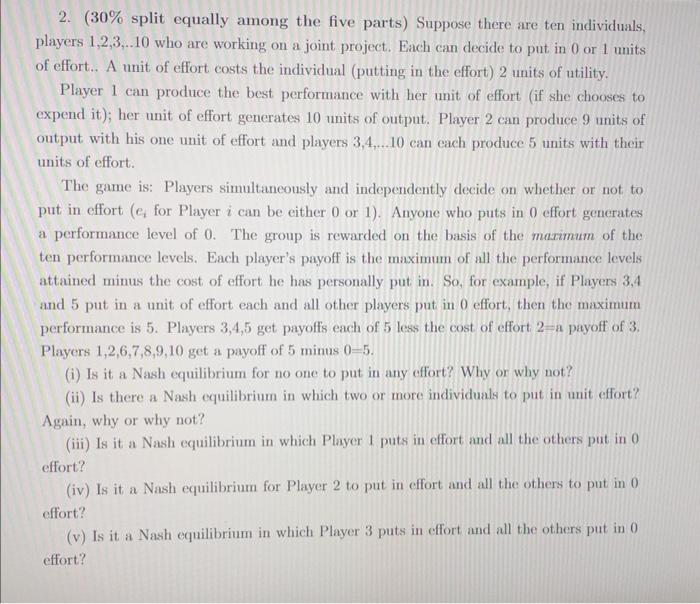2. ( 30% split equally among the five parts) Suppose there are ten individuals, players 1,2,3,10 who are working on a joint project. Each can decide to put in 0 or 1 units of effort.. A unit of effort costs the individual (putting in the effort) 2 units of utility. Player 1 can produce the best performance with her unit of effort (if she chooses to expend it); her unit of effort generates 10 units of output. Player 2 can produce 9 units of output with his one unit of effort and players 3,4,.10 can each produce 5 units with their units of effort. The game is: Players simultaneously and independently decide on whether or not to put in effort (ei for Player i can be either 0 or 1 ). Anyone who puts in 0 effort generates a performance level of 0 . The group is rewarded on the basis of the maximum of the ten performance levels. Each player's payoff is the maximum of all the performance levels attained minus the cost of effort he has personally put in. So, for example, if Players 3,4 and 5 put in a unit of effort each and all other players put in 0 effort, then the maximum performance is 5. Players 3,4,5 get payoffs each of 5 less the cost of effort 2= a payoff of 3 . Players 1,2,6,7,8,9,10 get a payoff of 5 minus 0=5. (i) Is it a Nash equilibrium for no one to put in any effort? Why or why not? (ii) Is there a Nash equilibrium in which two or more individuals to put in unit effort? Again, why or why not? (iii) Is it a Nash equilibrium in which Player 1 puts in effort and all the others put in 0 effort? (iv) Is it a Nash equilibrium for Player 2 to put in effort and all the others to put in 0 effort? (v) Is it a Nash equilibrium in which Player 3 puts in effort and all the others put in 0 effort? 2. ( 30% split equally among the five parts) Suppose there are ten individuals, players 1,2,3,10 who are working on a joint project. Each can decide to put in 0 or 1 units of effort.. A unit of effort costs the individual (putting in the effort) 2 units of utility. Player 1 can produce the best performance with her unit of effort (if she chooses to expend it); her unit of effort generates 10 units of output. Player 2 can produce 9 units of output with his one unit of effort and players 3,4,.10 can each produce 5 units with their units of effort. The game is: Players simultaneously and independently decide on whether or not to put in effort (ei for Player i can be either 0 or 1 ). Anyone who puts in 0 effort generates a performance level of 0 . The group is rewarded on the basis of the maximum of the ten performance levels. Each player's payoff is the maximum of all the performance levels attained minus the cost of effort he has personally put in. So, for example, if Players 3,4 and 5 put in a unit of effort each and all other players put in 0 effort, then the maximum performance is 5. Players 3,4,5 get payoffs each of 5 less the cost of effort 2= a payoff of 3 . Players 1,2,6,7,8,9,10 get a payoff of 5 minus 0=5. (i) Is it a Nash equilibrium for no one to put in any effort? Why or why not? (ii) Is there a Nash equilibrium in which two or more individuals to put in unit effort? Again, why or why not? (iii) Is it a Nash equilibrium in which Player 1 puts in effort and all the others put in 0 effort? (iv) Is it a Nash equilibrium for Player 2 to put in effort and all the others to put in 0 effort? (v) Is it a Nash equilibrium in which Player 3 puts in effort and all the others put in 0 effort







